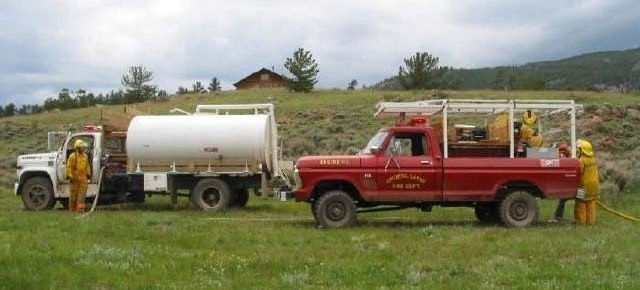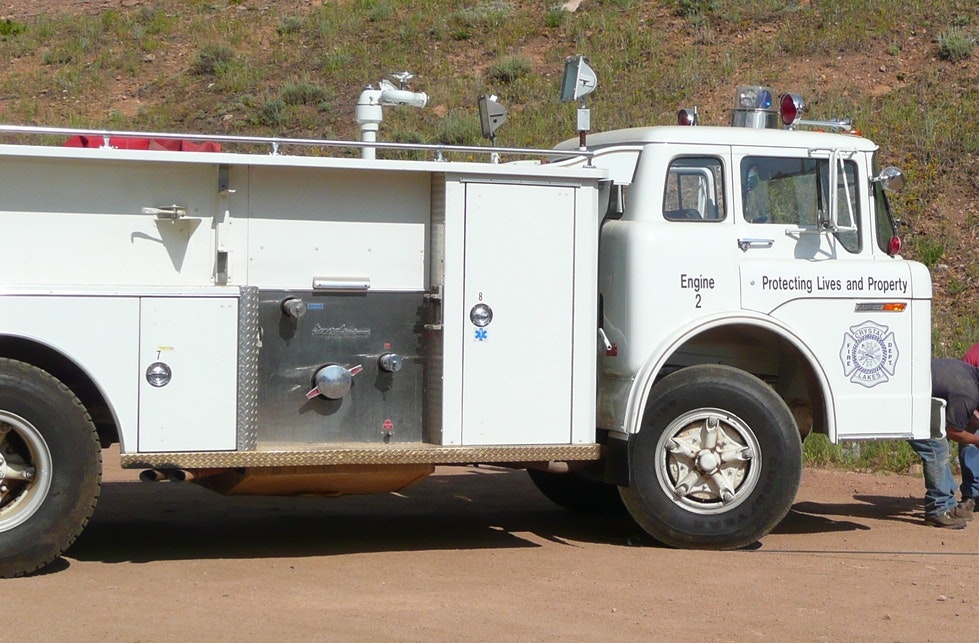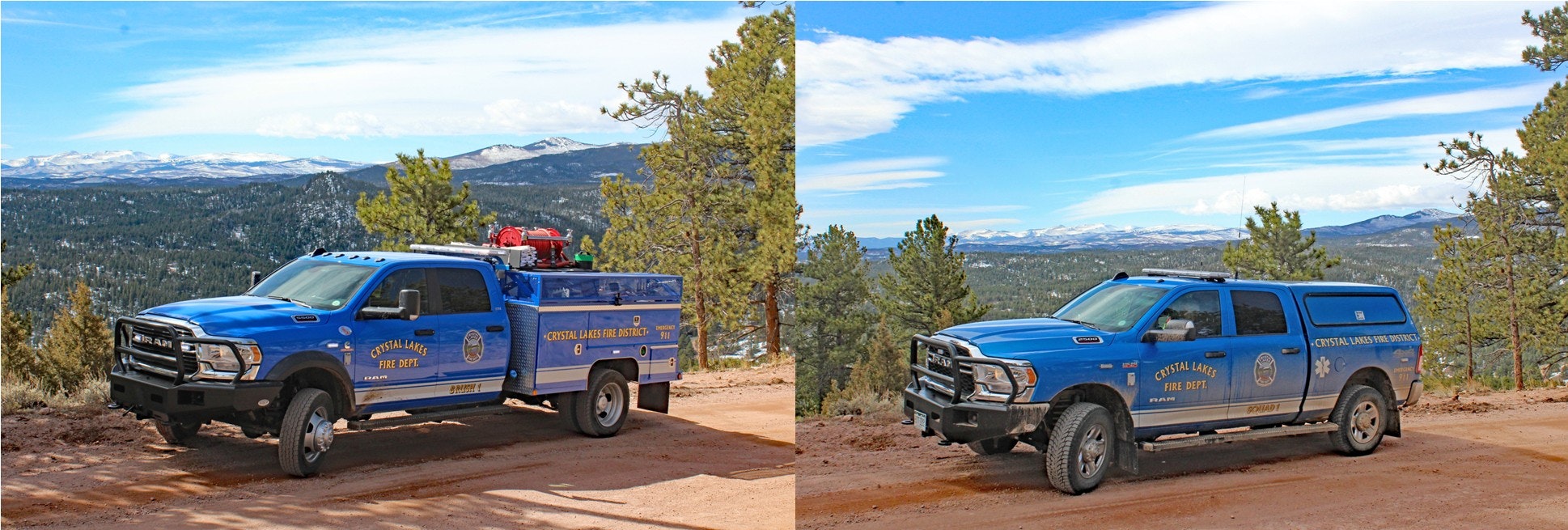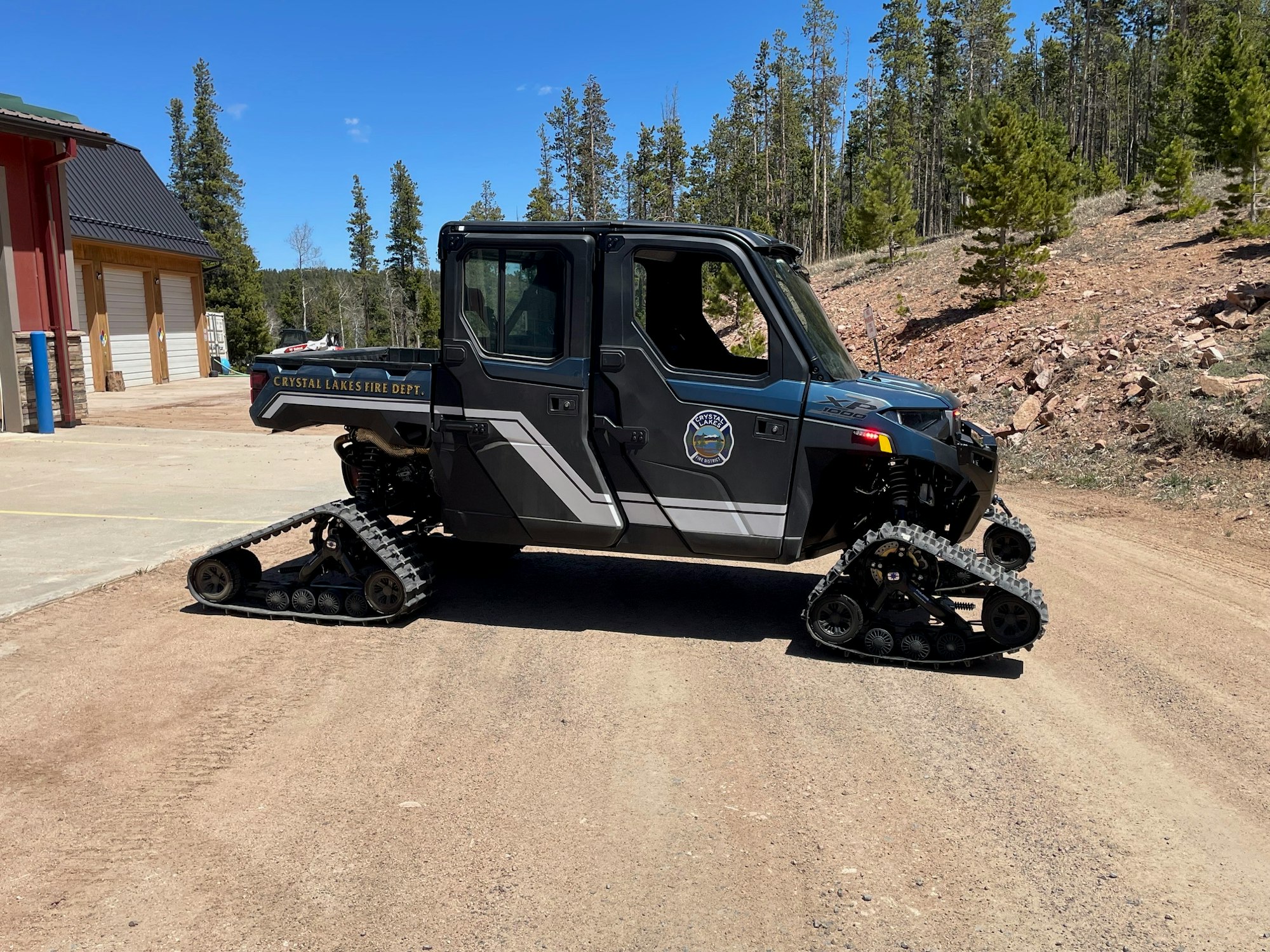CLVFD Then and Now

Pre-1995 Crystal Lakes Volunteer Fire Department is funded and operated by the Crystal Lakes Road and Recreation Association. Both CLRRA and the Crystal Lakes Water & Sewer Association, operating jointly under the heading of Crystal Lakes Associations (CLA), cooperate to provide equipment and support to the department. CLVFD owns a 1974 Ford pickup outfitted for fire response and uses it as its primary responding vehicle. CLWSA provides their water truck for hauling water for fighting structure fires and their sewer truck to provide water for fighting wildland fires. Later, CLRRA adds two vehicles referred to as the "Uglies," CDOT trucks that can haul water or dump debris as needed. The cooperation of all three organizations is vital, with the two property owners’ associations assisting the fire department by providing equipment and personnel as needed to the fledgling fire department.

1995 Crystal Lakes Fire Protection District is established by the voters with tax funding of 5.0 mills. The District purchases the shop/maintenance building at 237 Blackfoot Road from CLRRA to be the location of the “fire barn.” The department slowly builds its fire response capabilities, and by the early 2000s, fire apparatus includes the previously mentioned1974 Ford pickup outfitted for fire response, a 1980 GMC 7000 Mini Pumper (structure engine), 1973 Ford Pumper (used for structure fire response), 1979 Chevy C70 (tender), 1988 Chevy 1-ton (brush truck for wildland response), 1991 Chevy Suburban (Squad truck still in use today, primarily as a snowplowing vehicle).

1997 CLVFD trains its first Safety Officer, who takes classes to be fully qualified in the role. Following Safety Officers are also sent through professional training to ensure they’re knowledgeable in this vital task. CLVFD has always focused on safety -- for its firefighters, mutual aid personnel, and the public.

1998 CLVFD provides mutual aid support to Red Feather Lakes VFD in fighting the fire when the newly built Morning Star Church burns in December of this year. A hole is chipped in the ice on Lake Hiawatha to provide access to water, and a CLA employee serves as water boss to refill trucks.
2005 Wellington Fire Dept donates a brush truck to CLVFD – our first proper brush truck (not created in-house from a pickup truck), seating five crewmembers with built-in water tank and pump. This vehicle is retained as part of our emergency response fleet until it’s replaced in 2021 by a purpose-built brush truck bought with community donations.
2007 Tender 1, a 2007 4WD Freightliner with a 2,000-gallon carrying capacity, is purchased, replacing the 29-year-old repurposed water truck with no baffles (baffles prevent the water from sloshing around and overbalancing the vehicle) that had been used since at least 1995. This is CLVFD’s first brand new vehicle and is still in operation today.

2008 Via donations and targeted fundraising, CLVFD purchases ice rescue equipment and arranges for all department members and six members of Red Feather Lakes VFD to receive ice rescue training by Dive Rescue International, making the department fully capable of coldwater rescue for the first time.

2008 A 1988 International structure engine is purchased in preparation for the end of the operational life of the 1980 GMC 7000 Mini Pumper, which is showing signs of impending structural failure.
2008 SCBA (self-contained breathing apparatus) compressor, packs, and tanks are donated by Johnstown Fire Department (donation arranged by CLVFD member Harold Alexander). For the first time, CLVFD is fully kitted out with modern SCBA equipment to protect its members from smoke inhalation, the ability to safely make entry into smoky situations, and the ability to refill its own SCBA tanks.
2009 Apparatus in 2009 include: 2007 Freightliner Tender, 1988 International structure engine, 1980 GMC 7000 Mini Pumper structure engine, 1988 Chevy 1-ton brush truck, 1994 Ford F1 SuperDuty brush truck, and 1991 Chevy Suburban (Squad truck still in use today).
2010 The role of Special Duty Responders is created, allowing community members who wish to respond to emergency calls but aren’t capable of or don’t feel comfortable with firefighting duties to become valuable responding members of the department. SDRs led responders from outside our district to emergency scenes, established traffic control around scenes and helicopter landing zones, and managed logistics.
2010 CLVFD gains its first certified First Responders, now called Emergency Medical Responders (EMRs), with training at one level below an EMT. A cadre of six department members go through the training and certification process, marking the first time CLVFD has its own certified medical responders. Funding for the class is provided by a FEMA grant.
2011 CL FIRES, a non-profit 501(c)(3), is created to support Crystal Lakes VFD through fundraising and grant opportunities. CL FIRES also awards grants to other local community groups for the purpose of supporting community emergency services and encouraging education for fire prevention and personal safety.
2012 Using a FEMA grant, CLVFD installs a repeater tower, greatly improving radio communications during emergency response.
2015 CLVFD holds its first summer education classes. The line-up began with mitigation, evacuation, and wildfire insurance (classes either still taught today or still available on our website). The department also begins its program of offering mitigation assessments to property owners, giving one-on-one mitigation advice to those who request it (a program also still in operation today).
2015 CLVFD gains its first certified Emergency Medical Technician (EMT). As the department doesn’t have a full medical program of its own, all CLVFD EMTs must be joint members with Red Feather Lakes VFD in order to run as part of their medical program.
2015 The Beartrap Fire burns just over 18 acres in the Second Filing of Crystal Lakes. Firefighters from Red Feather Lakes VFD, Glacier View VFD, Livermore VFD, and Larimer County Emergency Services join forces with Crystal Lakes VFD and collectively manage to keep the fire, burning up the steep slope between Beartrap Road and North County Road 73C, from burning any homes or spreading any further in the community.
2015 Voters approve a ballot measure funding remodel of the fire station, increasing its footprint to accommodate the larger apparatus now being made and improving its overall capacity to operate as a full-fledged fire station (and no longer the glorified maintenance building we called the fire barn). After jumping through all regulatory hoops, putting the job out for bid to ensure we were getting the best price, and extensive preparation work to ensure a smooth transition (including making arrangements to store vehicles and equipment in the Water & Sewer Building and operate out of their facility for an extended period), the remodel starts in mid-2016 and continues through 2017, with the grand reopening on 9/23/17.

2016 New SCBA tanks, packs, and a compressor fill station are funded via a state grant, replacing aging equipment and modernizing the system.
2020 The Cameron Peak Fire burns from 8/13/2020 through 12/2/2020, ultimately destroying over 208,000 acres west and south of Crystal Lakes. The Crystal Lakes community is evacuated for an extended period during this time and firefighters from CLVFD join national crews in patrolling the area, putting out hotspots, and protecting the community.
2021 Thanks to the generosity of the Crystal Lakes community, CLVFD is able to raise enough money following the Cameron Peak Fire to purchase two new vehicles. Through the work of department members to modify and outfit these vehicles, they become Brush 1 (a new wildland engine) and Squad 1 (a multi-purpose response vehicle). This is only the second time in the department’s history that it’s been able to purchase brand new vehicles.

2023 CLVFD gains its first certified Paramedic.
2023 A boat shed is built in Lakeview Park area. CLVFD had been trying for some time to improve its water response capabilities, which efforts had gone through several permutations, from a boat kept in the west-end boat storage to a boat on a trailer to a quick-inflating boat in a response vehicle, none of which were considered ideal for the purpose. The department was finally able to make arrangements with the Water & Sewer Association to get permission to establish a purpose-built boat shed in the Lakeview Park area off Panhandle Reservoir/Crystal Lake where our inflatable boat can be permanently stored, along with the engine, life vests, rescue equipment, and all other gear necessary for a water rescue.
2024 District voters approve a ballot measuring increasing the Crystal Lakes Fire Protection District’s base mill levy rate from its original 5.0 (unchanged since 1995) to 8.0 mills, greatly increasing the district’s ability to maintain and improve services moving forward.
2025 The Special Duty Responder program is ended and a Fire Auxiliary program begun. Unlike SDRs, Fire Auxiliary provide department support and logistics without responding to emergency calls.

2025 CLVFD purchases a multi-purpose UTV with snow tracks (for winter use, tires for summer) and a wildland firefighting “slide” (a unit that sits in the bed of the vehicle, containing a water tank and pump). This vehicle greatly increases our ability to respond to difficult-to-access locations with water for firefighting or reach the scene of medical incidents during the winter when roads may be snowpacked and difficult to traverse.
